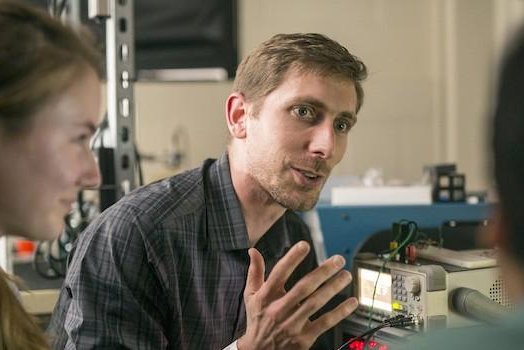Brett Byram, an assistant professor of biomedical engineering, is developing a helmet that would allow for brain ultrasound imaging. Photo by Daniel Dubois/Vanderbilt University
May 16 (UPI) -- Scientists first considered the possibility for a brain-imaging helmet powered by ultrasound technology more than 30 years ago.
"But it's been mostly ignored for the last decade," Brett Byram, an assistant professor of biomedical engineering at Vanderbilt University, told UPI.
It's not being ignored any longer. This month, Byram and his research partners at Vanderbilt received a $550,000 grant from the National Science Foundation to develop a device that combines ultrasound and EEG technologies to image the brain in real time.
"We're hoping that the grant will get us to the point of having a working helmet that has EEG and ultrasound working together," Byram said.
Current methods for imaging the brain are imperfect. Electroencephalography, or EEG, the technology that measures electrical activity in the brain, can't penetrate deep into the brain, offering only surface-level images.
"If you're looking for deeper or localized info, EEG doesn't always work," Byram said.
Functional magnetic resonance imaging, or fMRI, on the other hand, relies on big, heavy magnets.
Ultrasound technology works like an optical technology, with a lens that focuses waves on the imaging target. The technology sends and receives sound waves, which can detect blood profusion, or blood flow, in the brain.
Both ultrasound and its predecessor, transcranial doppler, have been traditionally used to measure blood flow in the brain's largest arteries and assess brain death.
Byram wants to do more than determine whether a brain is dead or not. He wants to use ultrasound and EEG to study the brain's blood flow and electrical patterns in real time -- a combination that could offer researchers a better understanding of the brain's complex architecture and the neural patterns triggered by thoughts, emotions and actions.
Of course, if ultrasound offered a simple solution to detailed, in-depth brain imaging, researchers would be using it already. While scientists can focus a beam of sound waves with great precision, the waves don't exactly return in an organized fashion.
"You get waves bouncing around the brain coming back from all different locations," Byram said. "It's very hard to keep the signals in their respective categories."
The research team at Vanderbilt, however, has developed machine learning algorithms to sort the waves and isolate the signals returning from the imaging target. When combined with EEG, the technology could offer the most detailed and comprehensive images of the brain yet.
In addition to imaging and studying brain activity, Byram hopes his helmet can eventually replicate brain signals. The technology could be integrated with software, artificial limbs and other types of robotics, turning thoughts into actions.
So far, Byram and his colleagues have been working on the basic functionality of the different technological components, mostly using a liver instead of a brain as a test bed.
"We have a lot of the pieces," he said. "The thing that we're starting work on now is integrating those things for the functional task of brain imaging. Then we're going to actually start designing and constructing the helmet."
"I think it will be first prototype in two or three years, and a decent working helmet in four or five years," Bryam said.















